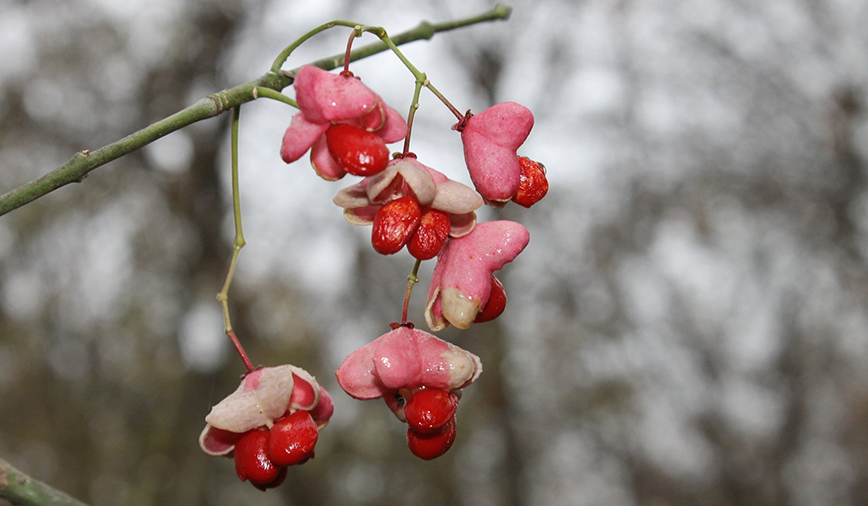October 5, 2012
Wahoo! Fall color is at its peak here in the TriCities!
The leaves changed a few weeks earlier this year, no doubt a sign of the stressful conditions our trees and shrubs endured during the 2012 Drought. But, cause aside, vibrant hues of crimson, gold and luscious brown greet us each day as local trees surrender their last green bits of chlorophyll and begin their preparations for winter. A light wind brings these colors fluttering downward, a flurry of autumnal tones that disappear far too fast.
While the big guys like maples, hickories and oaks grab most of the glory, another woody plant is quietly going about its business—business that includes producing some of the most spectacular color this side of fireworks.
This shrub, considered uncommon in our local natural areas, is a showstopper unlike any other. Besides scarlet leaves, this plant also turns sports red-orange berries bursting forth from hot-pink pods. Red, orange, pink, all together on one plant; indeed, it’s enough to make you shout “Wahoo!”
If you did, folks nearby would probably consider you exuberant about native plants. And, if they know their plant species, they’d also consider you 100% correct.
Wahoo is the common name for Euonymus atropurpureus, a large shrub native to our local natural areas. It’s partial to moist soil and can be found in rich woodlands as well as along streambanks.
You might be acquainted with some of wahoo’s cousins, the burning bush and spindle tree. These Asian and European imports, popular in landscape plantings, can offer a fair amount of fall color in their own right. But, as so often happens with nonnative species, they come with an assortment of bad habits.
Burning bush, Euonymus alatus, is the subject of a Weed Alert issued by The Nature Conservancy’s Global Invasive Species Team. Its resistance to pests and tolerance of shade make this plant quite capable of outcompeting our native shrubs in areas where it is introduced. Such introductions occur frequently thanks to birds that eat the shrub’s fruits, which are produced in prodigious quantities. Seeds that pass through the birds’ digestive tracts germinate easily and over time lead to monoculture thickets.
Spindle tree, Euonymus europaeus, also planted ornamentally, is an invader in its own right. It, too, has fall color, but it pales in comparison to wahoo. As Dick Young wrote in Kane County Wild Plants & Natural Areas, “The leaves have a washed-out pink or yellowish cast in autumn and one has to wonder why this wimp is promoted instead of our much more attractive native Wahoo.”
Part of the reason may lie in the confusion created by people’s use of common names. All three species, plus their many cultivars, fall under the umbrella name “burning bush.” And burning bush is the sort of name that readily sticks in people’s minds. The words themselves produce a vivid mental image; also, if you’ve ever sat in Sunday school, the name might resonate as the place where Moses received his marching orders.
If you’d like to add wahoo, and not its Eurasian relatives, to your yard’s plantings, be sure to shop using the plant’s two-part scientific name. Don’t let the Latin intimidate you. Euonymus means “good name” and atropurpurea references the plant’s springtime purple flowers. All you have to do is remember that Euonymus atropurpurea is a good name for purple color, and fall colors too.
Want to see wahoo in all its seasonal radiance? Come visit us at the Hickory Knolls Discovery Center. You’ll find wahoo shrubs, labeled with both their common and scientific names, right outside the front door. In fact, we’re such wahoo fanatics, we’ve also paid tribute to the plant indoors. The Wahoo Room, labeled with a gorgeous hand-painted picture of its namesake, is Hickory Knolls’ home base for birthday parties and science and nature classes.
Whether indoors or out, give a shout of recognition—a big “Wahoo!”—when you spot E. atropurpurea. We’ll be listening for you!

